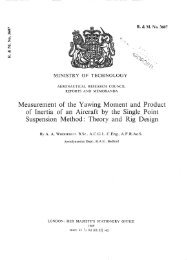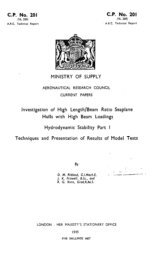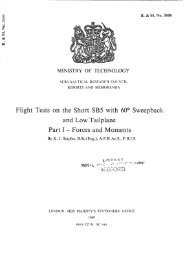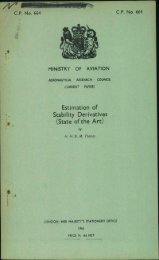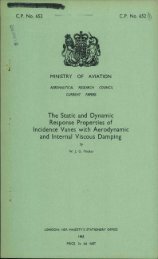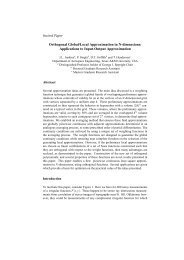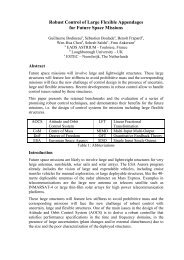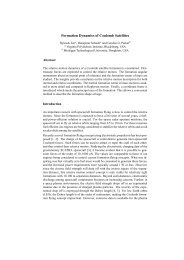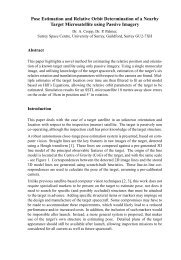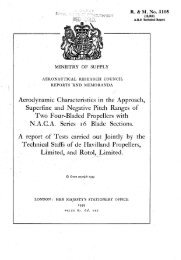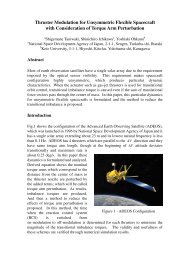The Aerodynamic Characteristics of Flaps
The Aerodynamic Characteristics of Flaps
The Aerodynamic Characteristics of Flaps
You also want an ePaper? Increase the reach of your titles
YUMPU automatically turns print PDFs into web optimized ePapers that Google loves.
Fig. 13. This fact, as well as the close agreement shown, between the estimated and measured<br />
values <strong>of</strong> ACr', illustrates the consistency <strong>of</strong> the results obtained with widely dissimilar flaps<br />
when analysed on the basis <strong>of</strong> effective chord.<br />
6.3.2. Fowler plus split flap.--<strong>The</strong> results <strong>of</strong> the R.A.E. tests <strong>of</strong> a 0.4c Fowler flap combined<br />
with a 0.1c split flap 76 are given in Table 2 and are also included in Fig. 16. <strong>The</strong> split flap was<br />
hinged to the lower surface <strong>of</strong> the Fowler flap in the trailing edge position. It will be seen that<br />
with the optimum setting (35 deg for the Fowler, 45 deg for the split flap) the split flap helps<br />
to raise the maximum lift coefficient increment from about 2.0 to 2-4 for a Surprisingly small<br />
cost in pr<strong>of</strong>ile drag. <strong>The</strong> ratio --A C,,,,/A CL is high and is much the same as for the single Fowler<br />
flap.<br />
6.3.3. Double Fowlerflap (Fig. lj).--<strong>The</strong> front flap <strong>of</strong> the double Fowler as tested at the R.A.E.<br />
is virtually a 0.4c slotted flap <strong>of</strong> the N.A.C.A. type, and it is the rear flap which provides the<br />
essential Fowler characteristic by extending backwards from its housing in the front flap to a<br />
distance practically equal to its own chord length. <strong>The</strong> lift coefficient increment attained by<br />
this combination is the highest <strong>of</strong> all the flaps examined 70, being about 2.65. <strong>The</strong> drag coefficient<br />
increment is small; but like that <strong>of</strong>, the Fowler or Fowler plus split flap the value <strong>of</strong><br />
-- (A C,~,/A Cr) is high.<br />
Again we may note that for both the Fowler plus split flap and the double Fowler the value <strong>of</strong><br />
--(A C,,';/A CL') is about 0-23. For a split or plain flap <strong>of</strong> the same effective chord ratio on a<br />
wing <strong>of</strong> the same thickness this ratio would be about 0.24 (see Fig. 13).<br />
It is interesting to note that the optimum setting is about 15 deg for the front flap and about<br />
42 deg for the Fowler flap. It is, in fact, usual to find that for double flaps, where the rear flap<br />
extends the chord quite considerably, the optimum front flap angle is relatively small.<br />
6.4. N.A.C.A. Slotted <strong>Flaps</strong>.--6.4.1. N.A.C.A. single-slotted fla~s (Fig. ld).--<strong>The</strong>se have<br />
been dealt with in section 5, but for completeness some representative data have been included<br />
in Table 2.<br />
6.4.2. N.A.C.A. double-slotted flaps (Fig. lh, li).--Comprehensive tests have been made in<br />
America <strong>of</strong> two sets <strong>of</strong> double-slotted flaps, a relatively small chord combination, viz., 0.26c<br />
and 0-1c, and a large chord combination, 0.4e and 0.26c. <strong>The</strong> latter was tested on wings <strong>of</strong> NACA<br />
23012, 23021 and 230306~ section, the former on wings <strong>of</strong> NACA 23012 section 5s. <strong>The</strong> relative<br />
movements <strong>of</strong> the flaps when operated are given in Table 1, they are in fact the same as those<br />
adopted for the single flaps. 'In Fig. 15b, 15c the drag coefficient increments are plotted against<br />
the lift coefficient increments. <strong>The</strong> optimum flap angles for maximum lift increment combined<br />
with a relatively small drag increment vary slightly with wing section and with flap chords, but<br />
they are in the region <strong>of</strong> 30 deg to 40 deg for both flaps. With higher flap angles little lift is lost<br />
but there is a rapid increase <strong>of</strong> drag.<br />
<strong>The</strong> average values <strong>of</strong> A C,,,/A CL and A C,,/,/A CL' are summarised in the following table :--<br />
A C,,,,<br />
A C~',<br />
A CL<br />
A CL'<br />
0"26c, 0"lc flap (NACA 23012) .... --0"335 --0"29<br />
0"4c, 0"26c flap (NACA 23012) .... --0.34 --0.265<br />
0.4c, 0.26c flap (NACA 23021) .... --0-37 --0.29<br />
0-4c, 0.26c flap (NACA 23030) .... --0.59 --0.43<br />
As with the Fowler flaps, the values <strong>of</strong> AC,,'~/AC;' on the 12 per cent thick wing are in fair<br />
agreement with the corresponding values for split flaps given in Fig. 13. However, the doubleslotted<br />
flaps show a surprising increase <strong>of</strong> A C,,'~/ACL' with wing thickness. This increase<br />
occurs mainly at the higher values <strong>of</strong> A CL', and in fact the relation between A C,/~ andACL'<br />
tends to depart from linearity as the wing thickness increases. Probably, the difference between<br />
15



